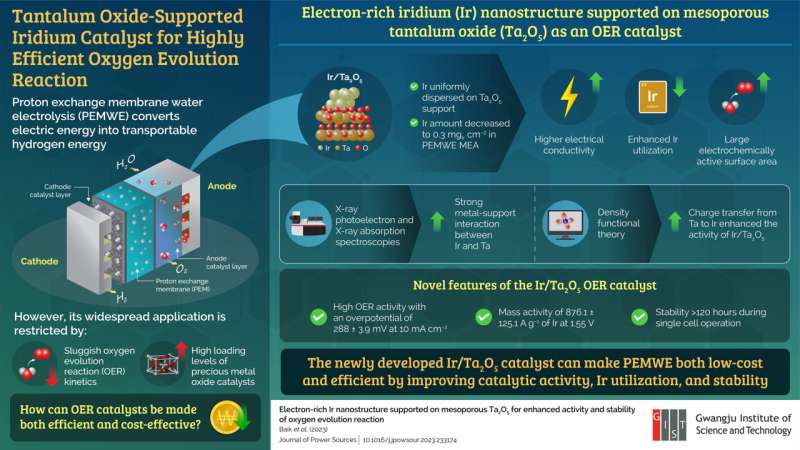Researchers design efficient iridium catalyst for hydrogen generation

The energy demands of the world are ever increasing. In our quest for clean and eco-friendly energy solutions, transportable hydrogen energy offers considerable promise. In this regard, proton exchange membrane water electrolyzers (PEMWEs) that convert excess electric energy into transportable hydrogen energy through water electrolysis have garnered remarkable interest.
However, their widescale deployment for hydrogen production remains limited due to slow rates of oxygen evolution reaction (OER)—an important component of electrolysis—and high loading levels of expensive metal oxide catalysts, such as iridium (Ir) and ruthenium oxides, in electrodes. Therefore, developing cost-effective and high-performance OER catalysts is necessary for the widespread application of PEMWEs.
Recently, a team of researchers from Korea and U.S., led by Professor Chanho Pak from Gwangju Institute of Science and Technology in Korea, has developed a novel mesoporous tantalum oxide (Ta2O5)-supported iridium nanostructure catalyst via a modified formic acid reduction method that achieves efficient PEM water electrolysis.
Their study was published in the Journal of Power Sources. The study was co-authored by Dr. Chaekyung Baik, a post-doctoral researcher at Korea Institute of Science and Technology (KIST).
“The electron-rich Ir nanostructure was uniformly dispersed on the stable mesoporous Ta2O5 support prepared via a soft-template method combined with an ethylenediamine encircling process, which effectively decreased the amount of Ir in a single PEMWE cell to 0.3 mg cm–2,” explains Prof. Pak. Importantly, the innovative Ir/Ta2O5 catalyst design not only improved the utilization of Ir but also facilitated higher electrical conductivity and a large electrochemically active surface area.
Additionally, X-ray photoelectron and X-ray absorption spectroscopies revealed strong metal–support interaction between Ir and Ta, while density functional theory calculations indicated a charge transfer from Ta to Ir, which induced the strong binding of adsorbates, such as O and OH, and maintained Ir (III) ratio in the oxidative OER process. This, in turn, led to the enhanced activity of Ir/Ta2O5, with a lower overpotential of 0.385 V compared to a 0.48 V for IrO2.
The team also demonstrated high OER activity of the catalyst experimentally, observing an overpotential of 288 ± 3.9 mV at 10 mA cm−2 and a mass activity of 876.1 ± 125.1 A g−1 of Ir at 1.55 V, significantly higher than the corresponding values for Ir Black. In effect, Ir/Ta2O5 exhibited excellent OER activity and stability, as further confirmed through membrane electrode assembly single cell operation of over 120 hours.
The proposed technology offers the dual benefit of reduced Ir loading levels and an enhanced OER efficiency. “The improved OER efficiency complements the cost-effectiveness of the PEMWE process, enhancing its overall performance. This advancement has the potential to revolutionize the commercialization of PEMWEs, accelerating its adoption as a primary method for hydrogen production,” speculates an optimistic Prof. Pak.
Source Link: https://phys.org/news/2023-08-efficient-iridium-catalyst-hydrogen-generation.html
















